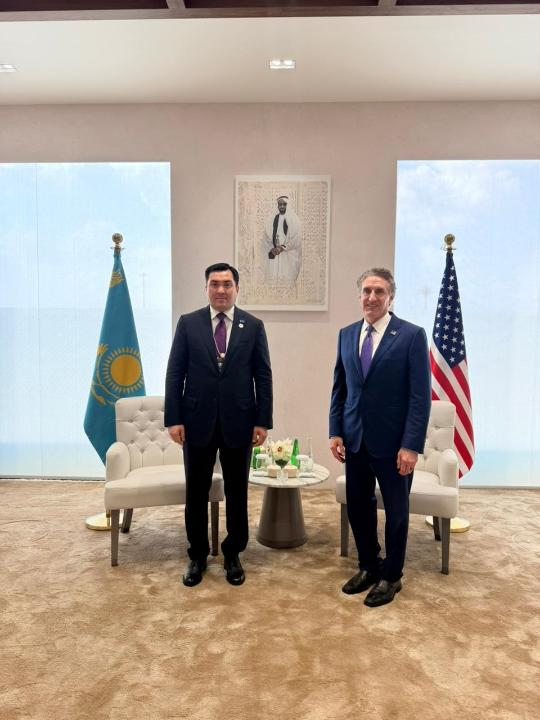ASTANA — The International Monetary Fund’s (IMF) Regional Economic Outlook, released on Oct. 21, showed that Central Asian economies continue to outperform expectations, with growth projected at 5.6% in 2025 before easing to around 4% in the medium term.
Azour noted the region’s potential to evolve into a true economic platform and connector. Photo credit: IMF
To understand what lies behind this resilience and how the region can turn it into lasting prosperity, The Astana Times spoke with Jihad Azour, director of the IMF’s Middle East and Central Asia Department.
Central Asia: from transit route to economic connector
According to Azour, maintaining the current growth trajectory requires ensuring that the “engines of growth” continue to deliver strong results. He observed that the region has benefited from certain global developments, some of them unfortunate, which have enabled it to increase economic output, attract investment, and further advance its economy. However, Azour emphasized that going forward, the region must focus on several key opportunities and priorities.
“What are the opportunities? The first opportunity is greater integration. Greater integration would allow the region to create an internal market that is larger and also more attractive for investors, including foreign investors. This requires a number of structural reforms to open up markets, increase connectivity between countries, and remove structural barriers,” he said.
He pointed out another opportunity stemming from new trade routes that emerged in the wake of post-COVID fragmentation, which disrupted global value chains.
“The region is emerging as one of the connectors between East and West, between China and Europe, and also between new geographies that have become potential trade and investment partners, like the Gulf Cooperation Council and others. To achieve this, countries must, in addition to strengthening regional integration, build both soft and hard infrastructure to attract more trade and investment through the region. This requires aligning regulations between countries, accelerating connectivity in roads, energy, and so on, and improving rules and regulations,” he said.
Azour added that creating opportunities is possible through accelerating structural reforms. The public sector, he said, should play a role in providing investment opportunities, while transforming itself to support small and medium-sized enterprises and expand the private sector’s role in the economy. This, in turn, would attract investment and accelerate growth.
Kazakhstan’s growth outlook: inflation still a concern
Zooming in on Kazakhstan, the IMF’s Regional Economic Outlook projects the country’s economy to grow by nearly 6% in 2025, driven by strong domestic demand and rising hydrocarbon output. Yet, inflation remains among the highest in the region.
When asked what steps Kazakhstan should take to balance growth with price stability, particularly amid rapid credit expansion and increased fiscal spending, Azour explained that Kazakhstan’s high inflation partly reflects spillover effects from Russian inflation, and partly domestic factors, such as accelerated demand.
“It has translated into a higher level of growth, but inflation has reached, especially recently, levels that need to be addressed,” he said.
He noted that the IMF welcomes the tightening measures already implemented by the National Bank of Kazakhstan and recommends that monetary policy remain restrictive until inflation approaches long-term targets.
“Additional rate hikes may be needed if inflation accelerates further. The first line of defense is to use monetary policy tools and send a clear signal that the monetary policy stance is aimed at addressing inflation,” he said.
Azour stressed that strengthening institutions would help enhance the credibility of both fiscal and monetary policies. Maintaining and reinforcing the central bank’s independence, he said, remains an important priority. Fiscal policy, in turn, should complement monetary efforts. Azour highlighted Kazakhstan’s reinstatement of the fiscal rule in 2024 and the development of a new tax code, noting these as positive steps.
“I think overhauling the whole fiscal framework and developing the right setup of reforms and measures that decouple fiscal policy from the oil and gas cycle while allowing fiscal policy to support monetary tightening are steps we welcome. Reforming the State-Owned Enterprises [SOEs] that have rapidly expanded their balance sheets is also an important step. Fiscal policy and reforms can not only strengthen fiscal performance and the fiscal framework but also support monetary policy,” he said.
Vigilance and reform: keys to weathering global headwinds
The IMF report underlined that Central Asia has demonstrated remarkable resilience to global shocks, including new U.S. tariffs and regional conflicts. When asked about the main risks facing Kazakhstan and its neighbors if global financial conditions tighten or commodity demand weakens, Azour said there are several dimensions to consider.
“The one that you’re referring to is the most important one because it’s related to changes in policies. The high level of uncertainty in policies makes it difficult to assess the course of action. Clearly, the first round of tariff measures had limited impact globally and on the region, mainly due to limited trade links. Take the case of Kazakhstan, its trade with the U.S. does not exceed four or five percent. But globally, we saw that market actors took a number of measures to anticipate those moves,” he said.
Azour warned that global inflationary pressures could lead to tighter monetary policies and higher interest rates, which could negatively affect growth.
“Second, demand may slow down, especially for energy, and the slowdown in demand will bring prices down. Therefore, one has to be vigilant. Short-term measures should focus on keeping policies tight, maintaining control over inflation, calibrating fiscal policy to support monetary tightening, and accelerating SOE reforms to create more space for growth,” he said.
He also noted that the region has the potential to evolve from a simple transit corridor into a true economic platform and connector.
“You need to allow investors to come, accelerate the reform of SOEs, and bring the private sector to the lead. Those are important measures that would allow faster growth. Strengthening the existing level of cooperation and advancing regional integration will create a larger and deeper market, improve productivity, and attract investors who can serve the entire region efficiently,” he said.
Azour concluded by pointing to both opportunities and risks arising from the rapid acceleration of technology.
“AI, digital currencies, crypto — those are important investments in the future, but they also come with certain risks and require policies to be adjusted to preserve stability,” he said.





